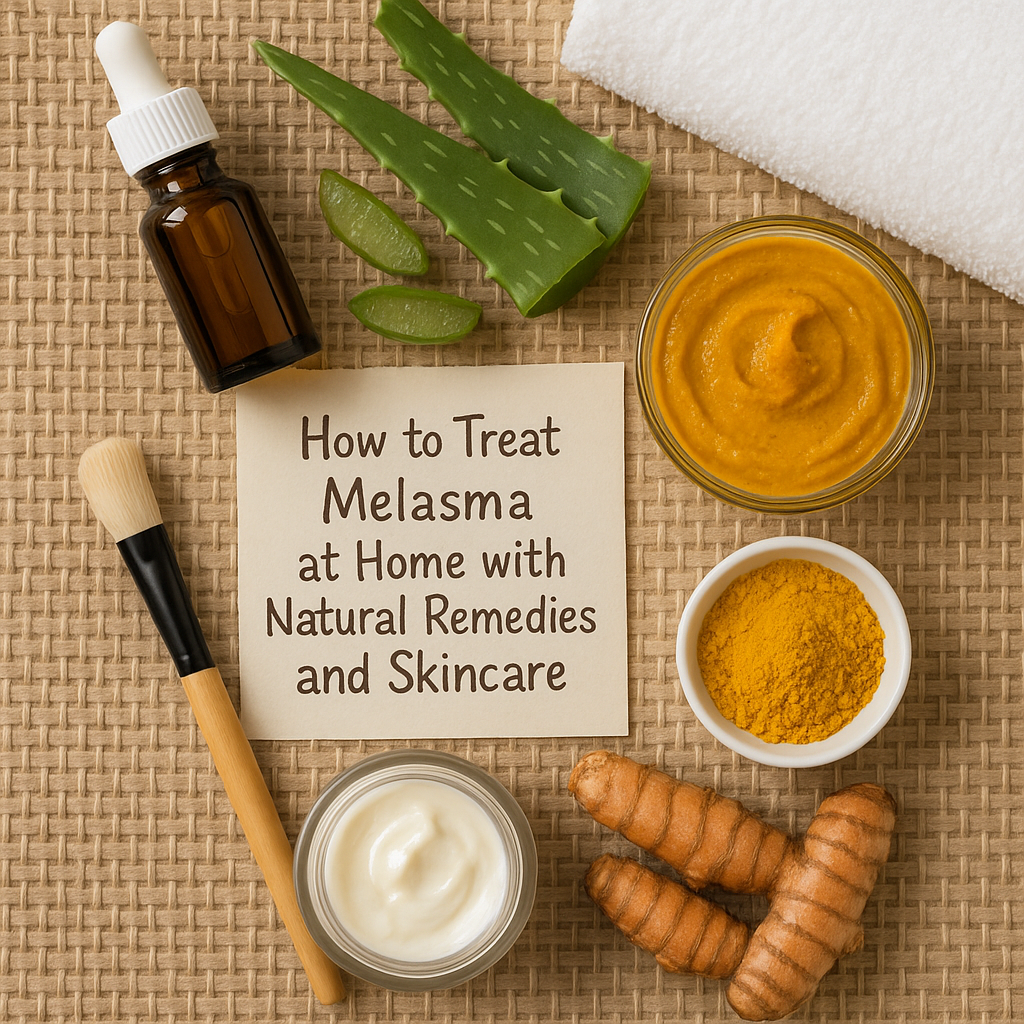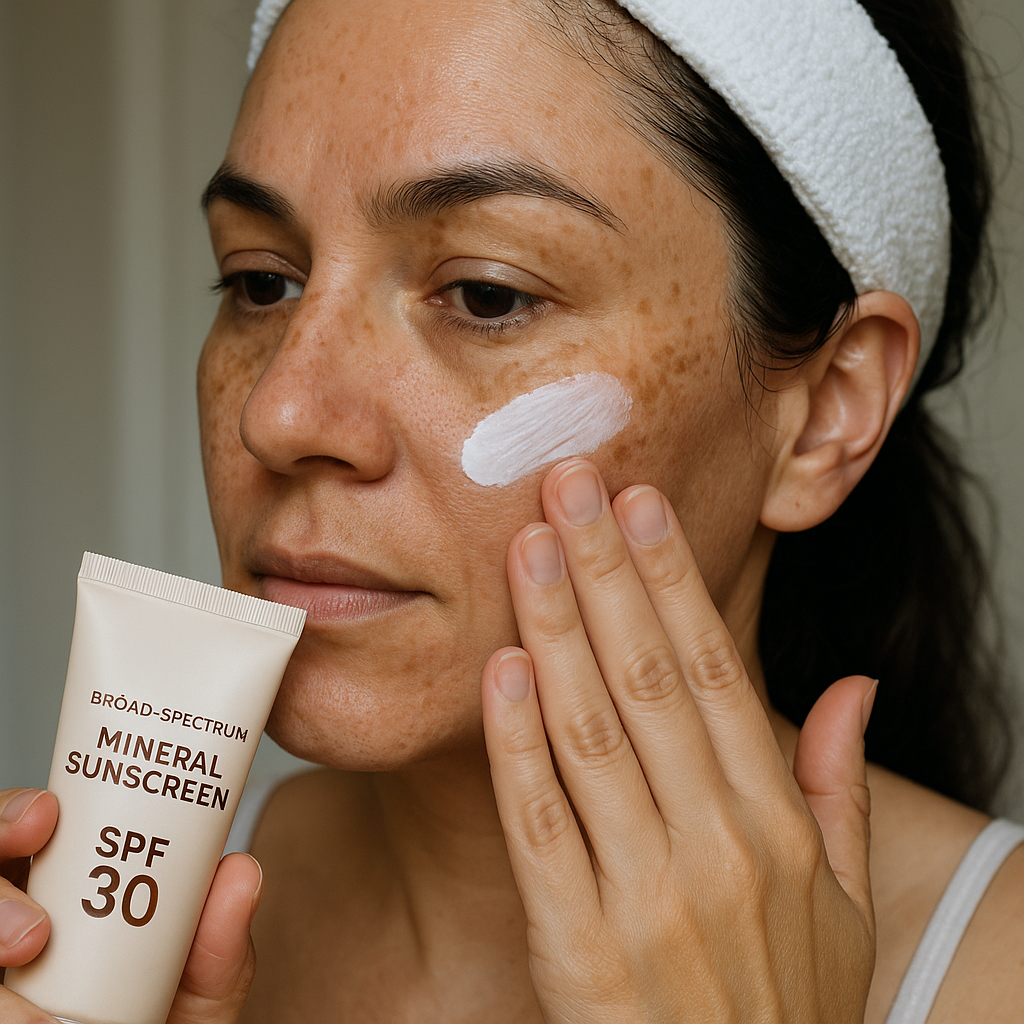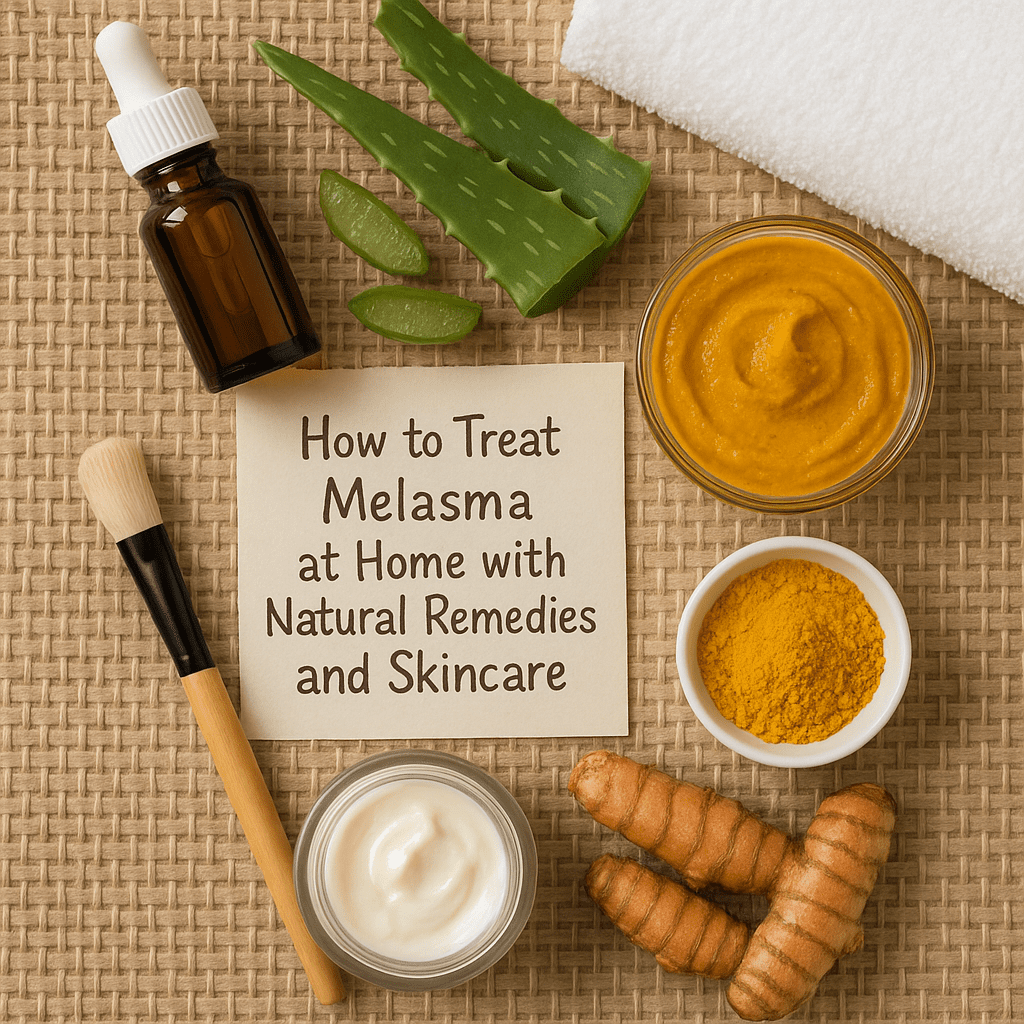Melasma is a common skin condition characterized by dark, discolored patches on the face.
But what exactly causes it, and how can you treat melasma at home effectively?
This comprehensive guide covers everything you need to know about treating melasma at home, from natural remedies to lifestyle changes.
Some are simple changes in your diet that support skin health.
Some are topical, natural ingredients you can apply safely.
Some are daily habits that protect your skin from further damage.
Some require patience but offer lasting improvements.
Some combine modern skincare science with traditional wisdom.
Let’s dive right in.
Why Does Melasma Happen and Why Focus on Home Treatments?
Melasma is caused by an increase in melanin production, often triggered by hormonal changes, sun exposure, and genetics. Common triggers include pregnancy, birth control pills, thyroid issues, and ultraviolet (UV) light.
Since melasma affects visible areas such as cheeks, forehead, and upper lip, it can cause emotional distress. While professional treatments exist, many prefer to start with home care for several reasons:
- Lower cost and accessibility
- Ability to maintain treatment long-term
- Comfort using natural and gentle ingredients
- Complement professional interventions
Tackling melasma from home means combining sun protection, targeted skincare, and lifestyle changes to reduce pigmentation and prevent flare-ups. It empowers you to take control of your skin every day.
How Can I Protect My Skin to Prevent Further Melasma?
The single most important step in treating melasma at home is rigorous sun protection. UV rays drive melanin production and worsen discoloration.
Choose the right sunscreen. Opt for broad-spectrum, physical (mineral) sunscreens containing zinc oxide or titanium dioxide. These block both UVA and UVB rays as well as visible light, which can also trigger melasma.
Unlike chemical sunscreens, these are less likely to irritate sensitive skin or worsen pigmentation.
Apply sunscreen liberally and reapply every two hours, especially if you’re outdoors or sweating.
Don’t forget other forms of protection:
- Wear wide-brimmed hats and UV-protective clothing
- Avoid sun exposure during peak hours (10 a.m. to 4 p.m.)
- Use tinted makeup with iron oxide for added visible light protection
- Remember that visible light passes through glass—use window films or wear protection indoors if near windows
This vigilance forms the foundation for any successful melasma treatment both at home and professionally (source).
What Natural Remedies Can I Try at Home for Melasma?
When it comes to treating melasma at home, certain natural ingredients have shown promise in reducing pigmentation and improving skin tone.
1. Aloe Vera
Aloe vera gel contains aloin, a compound with depigmenting effects. Applying fresh aloe gel twice daily to melasma patches can soothe irritation and gradually lighten dark spots. Aloe vera also moisturizes, boosting skin barrier function to prevent further damage.
2. Turmeric
This bright yellow spice is prized for anti-inflammatory and skin-brightening properties. Mixing turmeric powder with milk to form a paste and applying for 15-20 minutes can reduce pigmentation over time. Regular use may lead to clearer, radiant skin.
3. Tomato Paste
Rich in lycopene, a powerful antioxidant, tomato paste mixed with olive oil makes a face mask protecting skin against UV damage. Applying twice weekly can lighten hyperpigmentation and even your complexion.
4. Red Lentil Face Mask
Antioxidants in red lentils can reduce pigmentation. Soak lentils overnight, blend to a paste, then apply for 20 minutes before washing off. Use regularly for noticeable results.
5. Parsley Tea
Applying cooled parsley tea with a cotton ball can harness its anti-inflammatory and antioxidant effects. Daily use soothes skin and helps fade melasma patches.
These remedies work best as complementary treatments while maintaining consistent sun protection to avoid further pigment formation (source).
Did you know? Combining these natural remedies with daily sunscreen use improves your chances of lasting improvement.
What Diet and Lifestyle Changes Support Melasma Treatment at Home?
Since oxidative stress plays a role in melasma, eating a diet rich in antioxidants helps combat free radicals that trigger pigment production.
- Boost Vitamin C intake: Citrus fruits, strawberries, bell peppers
- Include Vitamin E: Nuts, seeds, and vegetable oils
- Consume foods rich in Vitamin B12 and D, especially if deficient
- Drink plenty of water to maintain skin hydration
- Avoid excessive heat exposure such as hot showers or saunas, which can worsen pigmentation
Manage stress through mindfulness, yoga, or meditation because stress hormones can contribute to melasma flare-ups.
Avoid hormonal triggers where possible. If you suspect birth control or hormone therapy aggravates your melasma, discuss alternatives with your healthcare provider.
Maintaining a consistent cleansing routine is also key. Environmental pollutants can damage the skin barrier, making it more susceptible to pigmentation. Use gentle cleansers to remove dirt, makeup, and pollutants every evening.
Which Over-the-Counter Products Are Effective for Home Treatment of Melasma?
Besides natural remedies, certain topical ingredients with clinical backing can be integrated into your skincare to target pigmentation:
- Azelaic acid: Inhibits melanin production and reduces inflammation. Safe during pregnancy and effective for mild melasma.
- Niacinamide (Vitamin B3): Prevents pigment transfer between cells, improving skin brightness.
- Kojic acid: A natural antioxidant inhibiting tyrosinase, an enzyme critical in melanin synthesis.
- Vitamin C serums: Powerful antioxidants that can lighten dark patches and boost collagen.
Products combining these actives with sunscreen can amplify benefits. However, always patch test new products and introduce them gradually to avoid irritation.
For stubborn or severe melasma, some topical prescriptions like hydroquinone or retinoids require dermatologist guidance due to possible side effects (source).
How Can I Make Sure My Home Treatment for Melasma Is Effective?
Consistency is king in home treatments. Melasma requires patience; it can take several weeks to months to see improvement.
Document your skin’s progress with photos every 4 weeks. This helps identify what works and adjusts your routine.
Consider these tips for better results:
- Use sunscreen every single day regardless of whether you go outside
- Apply topical agents only on the pigmented areas to prevent unwanted lightening
- Moisturize well to maintain the skin barrier
- Avoid harsh scrubs or aggressive treatments that cause irritation and worsen melasma
- Integrate internal antioxidants from diet or supplements when approved by your doctor
- Stay vigilant about triggers like sun, heat, and hormonal changes
Remember, some recurrence is common. Maintenance therapy and protection must be lifelong to keep melasma under control.
When Should I Consult a Professional for Melasma Treatment?
If your melasma doesn’t improve after consistent home care and sun protection for several months, or if it worsens, it’s time to seek professional advice.
Dermatologists and med spas like Simcoe Cosmetic Clinic offer advanced treatments such as chemical peels and laser therapies that can provide targeted and potent results.
These treatments can be complementary to your home regimen, amplifying results while minimizing downtime.
For example, chemical peels use alpha-hydroxy acids to exfoliate pigmented layers gently, encouraging regeneration of clearer skin (check out chemical peel Barrie options). Meanwhile, laser treatments target melanin granules deeply to reduce pigmentation effectively.
Discuss your skin type and concerns with your specialist to design a personalized plan that fits your lifestyle and goals.
Why is patience important when dealing with melasma? The pigmentation process is complex and influenced by multiple factors such as hormones and environmental exposure. Quick fixes may be tempting but can cause rebound or worsening pigmentation. Sustainable improvements come from a disciplined, long-term approach combining protection, gentle care, and healthy habits.

Can I Use Home Remedies and Professional Treatments Together?
Absolutely. In fact, combining gentle home care with professional treatments often yields the best results.
Daily home routines reinforce and maintain improvements achieved by in-clinic procedures. However, it’s crucial to inform your provider about any topical products you use, as some ingredients may interfere with treatments or cause sensitivity.
After professional treatments such as chemical peels or laser therapy, your skin barrier might be temporarily compromised. Home remedies like aloe vera and moisturization support healing and comfort.
Scientific studies suggest that integrating antioxidants like Vitamin C serums at home can enhance laser treatment outcomes by protecting skin cells from oxidative stress (source).
Frequently Asked Questions About Home Treatment of Melasma
- How long does it take to see results from home treatment for melasma?
- Typically, noticeable improvements take 8 to 12 weeks of consistent care, but it can vary based on skin type and melasma severity.
- Are natural remedies safe to use during pregnancy?
- Most natural remedies like aloe vera and tomato paste are safe, but always consult your healthcare provider before starting new treatments during pregnancy.
- Can melasma be cured permanently?
- Melasma is a chronic condition with no permanent cure, but diligent sun protection and treatment can control and significantly reduce its appearance.
- Should I avoid all sun exposure if I have melasma?
- Avoid intense sun, especially during peak hours, but regular outdoor activities are possible with strict sun protection measures.
- Is it okay to use hydroquinone at home?
- Hydroquinone can be effective but should only be used under dermatological supervision due to possible side effects.
How committed are you to your skin’s health? Every step you take today shapes your skin’s future. Consistency beats shortcuts, and knowledge empowers you to make the right choices.

Table of Contents
- Why Does Melasma Happen and Why Focus on Home Treatments?
- How Can I Protect My Skin to Prevent Further Melasma?
- What Natural Remedies Can I Try at Home for Melasma?
- What Diet and Lifestyle Changes Support Melasma Treatment at Home?
- Which Over-the-Counter Products Are Effective for Home Treatment of Melasma?
- How Can I Make Sure My Home Treatment for Melasma Is Effective?
- When Should I Consult a Professional for Melasma Treatment?
- Can I Use Home Remedies and Professional Treatments Together?
- Frequently Asked Questions About Home Treatment of Melasma
What’s Your Next Step?
Tell us in the comments: How will you apply these strategies to treat melasma at home? For additional insights and expert care, explore more about our advanced skin rejuvenation treatments designed to complement your home care efforts.
Remember, lasting improvement starts with understanding your skin and committing to consistent, effective routines. Your path to clearer, radiant skin begins with informed choices today.
Discover how microneedling in Barrie can also support skin renewal and fade stubborn pigment spots, making it a valuable part of your melasma management journey.





